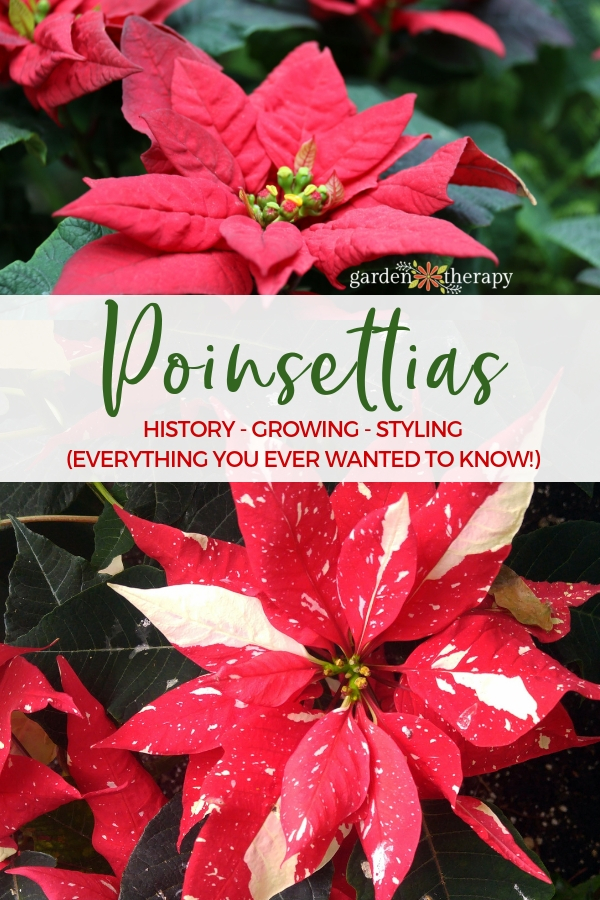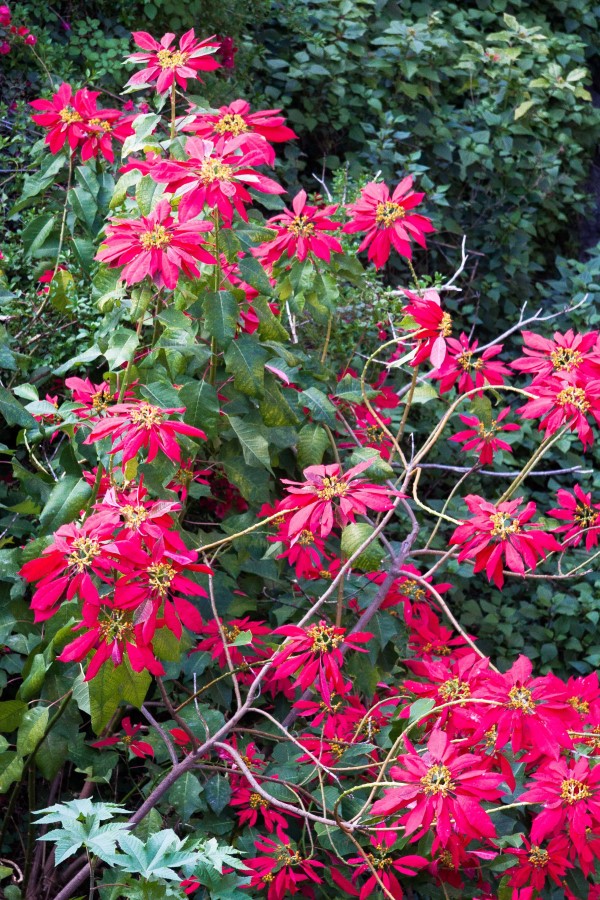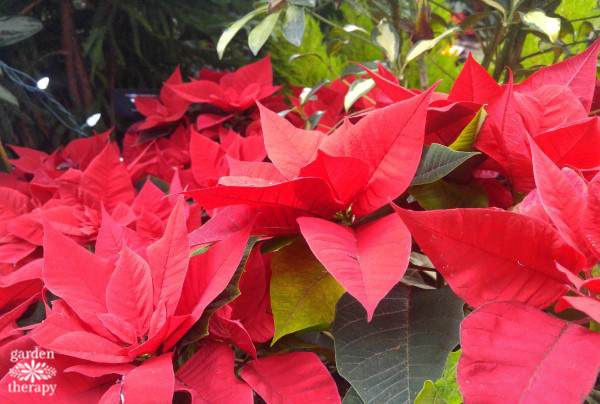If there was one plant that embodied the spirit of Christmas, poinsettias would be at the top of the list! These cheerful red blooms may be all over, but did you know how they became associated with Christmas? Here’s the fascinating history behind the plant, plus how to care for poinsettias.

We all see poinsettias everywhere we go throughout the holidays. They are for sale in pretty much any store you walk into, are a stand-by for school fundraisers, and can be seen in many peoples’ houses over the season. December 12th is even National Poinsettia Day in the United States!
In this post, we will cover:
All About Poinsettias
Poinsettias have become such a universal symbol for Christmas and winter that many people don’t realize that they are actually tropical plants that grow as large shrubs in the wild. By learning how to care for poinsettias and attention to detail, you can create a stylish poinsettia display that showcases these fiery crimson beauties.
Botany
It can be hard to picture poinsettias growing in the wild since we are so used to seeing them as houseplants. The poinsettia plant, Euphorbia pulcherrima, is native to western Mexico where it grows into a large shrub or small tree.


The large red “petals” are actually bracts and the small yellow centers are the flowers. Colourful bracts and small flowers are also seen on other common flowering shrubs and trees like dogwoods and hydrangeas.


History and Association with Christmas
Ancient Aztecs used the plant as a medicine to reduce fever. They also commonly used it for making a red dye that coloured cosmetics and textiles.
It wasn’t until the sixteenth century that poinsettia became commonly associated with Christmas. The plant’s December blooming time and star-shaped bracts that bring to mind the Star of Bethlehem are probably where the original connection with the holiday came from.
There is a Mexican Christmas tale about the origin of the poinsettia that tells the story of a young peasant girl who could not afford a proper offering for her Christmas prayer, so she placed a bundle of weeds on the church altar instead. The weeds began to bloom red and turned into beautiful large star-shaped flowers.


In the nineteenth century, Joel Roberts Poinsett, the United States’ first ambassador to Mexico and an avid gardener, fell in love with growing poinsettias and sent some back to his home in South Carolina, introducing them to the U.S. for the first time. The plant got its common name from Poinsett.
How to care for poinsettias
When it comes to growing poinsettias, most people purchase the plant rather than growing from seed or progagation. They’re everywhere during the holidays and are rather affordable too.
Begin by purchasing a plant that looks healthy. Choose one that is full and does not have discoloured leaves or other signs of disease.
Place poinsettias in a bright room that gets lots of natural light, but keep the plant out of direct sun. Place it somewhere away from drafty windows or heat sources since dramatic changes in temperature can harm the plant. Water only when soil feels dry to the touch. If your poinsettia is healthy, it will flower again next year (more on how to grow poinsettias year after year below!).


A lot of people avoid having poinsettias in the house because of the fear that they are dangerous to cats and dogs, but the plants are not as poisonous to pets as is commonly thought. They can only cause serious harm if ingested in huge amounts (your furry friend would have to eat hundreds of plants to be in real danger, according to a recent study).
They can cause some unpleasant tummy aches, though, so it’s best to keep them out of reach of pets anyway. For more on plants that can be harmful to dogs and cats, take a look at this post.
Styling
Taking a little bit of time to re-pot your poinsettia once you get it home makes a huge difference. Plant it in a decorative ceramic pot, something plain, or even a salad bowl—anything other than leaving it in that shiny foil wrapping it comes in will make it look SO much more sophisticated.


I know that you can buy poinsettias in all kinds of colours now such as blue, rainbow, and even glitter-covered ones, but I am just not a fan. If it is not some shade or combination of red and white, it is definitely dyed.


Poinsettias are beautiful when left natural, and I think that dyed flowers just look artificial and tacky, plus I don’t especially want to bring any harsh dyes into my home. The less chemicals, the better!
Leave the fake colours and pick a gorgeous natural poinsettia instead. You can find them in fiery red, white, cream, blush, or with candy-cane stripes!


FAQ on How to Care for Poinsettias
How Often Should I Water Poinsettias?
Water your poinsettias once they are dry to the touch or you notice wilting. Let them dry out completely between waterings. It’s important to have drainage for your poinsettia so it’s not sitting in water.
Do Poinsettias Like Sun or Shade?
A tropical plant from Central America, poinsettias like it hot. Place them by an east window if possible where they can get bright, indirect sunlight. You want to make sure that they do not touch any window panes with their leaves as it can easily damage them.


Do Poinsettias Come Back Year After Year?
Yes! You can get reblooms every year by learning how to care for poinsettias but it can be a tedious process. The idea is to mimic greenhouse conditions. After Christmas, continue to water and care for your poinsettia as mentioned above.
Around April, you will want to slowly decrease watering and move to a dark room. In the summer around June, keep your poinsettia in a shady location and pinch back any new stems approximately 1 inch. Fertilize and water regularly again.
In mid-August, return your poinsettia to a bright, indirect spot and try to maintain the temperature around 65°F.
This is the most important step. Beginning October 1st, your plant needs to be in total and complete darkness from 5 PM to 8 AM (or 14 hours a night). Any kind of exposure to light, from streetlamps to a tiny night light can disrupt the process. A closet is a good place to store it, along with a bowl of water for humidity. During the day, return it to a bright, indirect spot and continue with regular watering.
Do this until the last week of November (8 weeks). By then, you should begin to see the red buds coming in. You can stop placing the plant in total darkness and leave it in its usual spot.


How Long Can I Keep My Poinsettia Alive?
Your poinsettia is designed to make it through the holiday season. It can stay red for a couple of months with the right care, but will eventually drop its red leaves and turn green again. If you plan on keeping your poinsettia, you can cut back the plant to 6 inches and continue with the care.
They’re difficult to get to turn red again, but you can follow the care outlined listed above and aim for Christmas red again!
More Winter Flowers

